
In Christianity, Jesus is believed to be the Son of God or God in human form as written in the Bible's New Testament, and in most Christian denominations he is held to be God the Son, a prosopon (person) of the Trinity of God.

The Parable of the Talents is one of the parables of Jesus. It appears in two of the synoptic, canonical gospels of the New Testament:

The Parable of the Ten Virgins, also known as the Parable of the Wise and Foolish Virgins or the Parable of the ten bridesmaids, is one of the parables of Jesus. According to Matthew 25:1–13, ten virgins await a bridegroom; five have brought enough oil for their lamps for the wait, while the oil of the other five runs out. The five virgins who are prepared for the bridegroom's arrival are rewarded, while the five who went to buy further oil miss the bridegroom's arrival and are disowned.
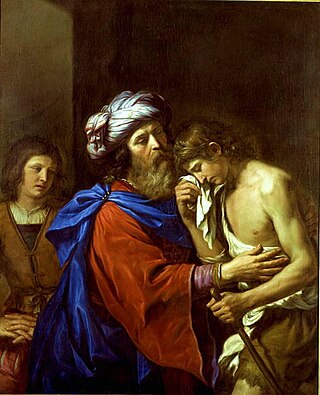
The parables of Jesus are found in the Synoptic Gospels and some of the non-canonical gospels. They form approximately one third of his recorded teachings. Christians place great emphasis on these parables, which they generally regard as the words of Jesus.
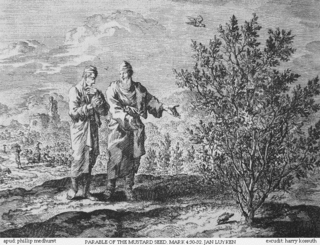
The Parable of the Mustard Seed is one of the shorter parables of Jesus. It appears in Matthew (13:31–32), Mark (4:30–32), and Luke (13:18–19). In the Gospels of Matthew and Luke, it is immediately followed by the Parable of the Leaven, which shares this parable's theme of the Kingdom of Heaven growing from small beginnings. It also appears in the non-canonical Gospel of Thomas.

The Parable of the Lost Sheep is one of the parables of Jesus. It appears in the Gospels of Matthew and Luke. It is about a shepherd who leaves his flock of ninety-nine sheep in order to find the one which is lost. It is the first member of a trilogy about redemption that Jesus tells after the Pharisees and religious leaders accuse him of welcoming and eating with "sinners."

The Parable of the Wise and the Foolish Builders, is a parable of Jesus from the Sermon on the Mount in the Gospel of Matthew as well as in the Sermon on the Plain in the Gospel of Luke.
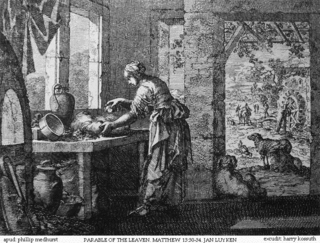
The Parable of the Leaven, also called the parable of the yeast, is one of the shortest parables of Jesus. It appears in Matthew 13:33 and Luke 13:20–21, as well as in the non-canonical Gospel of Thomas. In the canonical gospels it immediately follows the Parable of the Mustard Seed, which shares this parable's theme of the Kingdom of Heaven growing from small beginnings. In the Gospel of Thomas it starts a series of three, preceding the Parable of the empty jar and the Parable of the Strong Man.

The Parable of the Unforgiving Servant is a parable of Jesus which appears in the Gospel of Matthew. According to Matthew 18:21–35 it is important to forgive others as we are forgiven by God, as illustrated by the negative example of the unforgiving servant.

The Parable of the Two Debtors is a parable of Jesus. It appears in Luke 7:36–7:50, where Jesus uses the parable to explain that the woman who has anointed him loves him more than his host, because she has been forgiven of greater sins.

The Parable of the Friend at Night is a parable of Jesus which appears in Luke 11:5–8. In it, a friend eventually agrees to help his neighbor due to his persistent demands rather than because they are friends, despite the late hour and the inconvenience of it.

Luke 10 is the tenth chapter of the Gospel of Luke in the New Testament of the Christian Bible. It records the sending of seventy disciples by Jesus, the famous parable about the Good Samaritan, and his visit to the house of Mary and Martha. This Gospel's author, who also wrote the Acts of the Apostles, is not named but is uniformly identified by early Christian tradition as Luke the Evangelist.

The Parable of the Great Banquet or the Wedding Feast or the Marriage of the King's Son is a parable told by Jesus in the New Testament, found in Matthew 22:1–14 and Luke 14:15–24.
The Parable of the Unjust Steward or Parable of the Penitent Steward is a parable of Jesus which appears in Luke 16:1–13. In it, a steward who is about to be fired tries to "curry favor" with his master's debtors by remitting some of their debts. The term "steward" is common in many English translations of the New Testament; some versions refer to a "manager", or an "accountant". This parable does not appear in the other gospels.
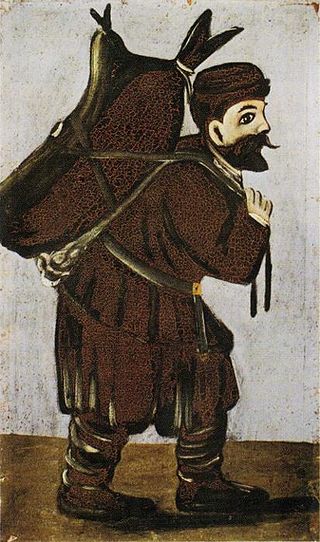
New Wine into Old Wineskins is a parable of Jesus. It is found at Matthew 9, Mark 2, and Luke 5.
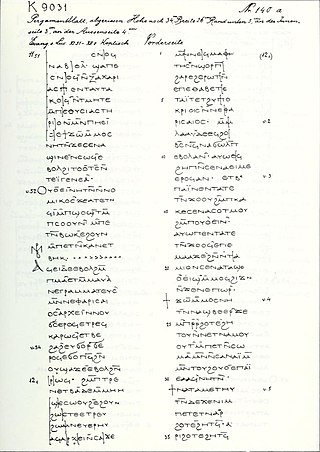
Luke 12 is the seventh chapter of the Gospel of Luke in the New Testament of the Christian Bible. It records a number of teachings and parables told by Jesus Christ when "an innumerable multitude of people had gathered together", but addressed "first of all" to his disciples. The book containing this chapter is anonymous, but early Christian tradition uniformly affirmed that Luke the Evangelist composed this Gospel as well as the Acts of the Apostles.

Luke 14 is the fourteenth chapter of the Gospel of Luke in the New Testament of the Christian Bible. It records one miracle performed by Jesus Christ on a Sabbath day, followed by his teachings and parables, where he "inculcates humility ... and points out whom we should invite to our feasts, if we expect spiritual remuneration". The book containing this chapter is anonymous, but early Christian tradition uniformly affirmed that Luke the Evangelist composed this Gospel as well as the Acts of the Apostles.
"Faithful and discreet slave" is the term used by Jehovah's Witnesses to describe the group's Governing Body in its role of directing doctrines and teachings. The group is described as a "class" of "anointed" Christians that operates under the direct control of Jesus Christ to exercise teaching authority in all matters pertaining to doctrine and articles of faith.

Healing the centurion's servant is one of the miracles performed by Jesus of Nazareth as related in the Gospel of Matthew and the Gospel of Luke. The story is not recounted in the Gospels of either John or Mark.

The Parable of the Wedding Feast is one of the parables of Jesus and appears in the New Testament in Luke 14:7–14. It directly precedes the Parable of the Great Banquet in Luke 14:15–24. In the Gospel of Matthew, the parallel passage to the Gospel of Luke's Parable of the Great Banquet is also set as a wedding feast.


















